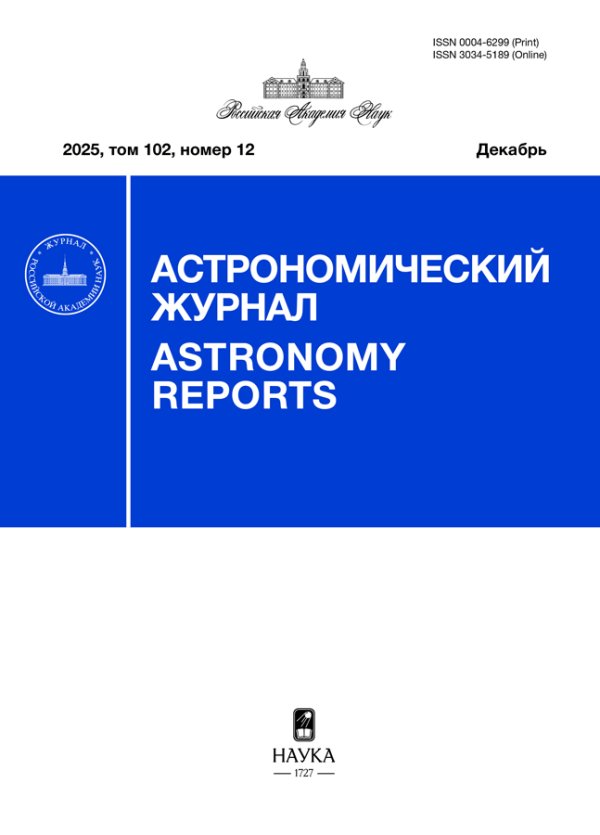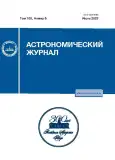Neural Networks for Searching for Meteoral Signals in the Data of the Orbital Telescope “UV Atmosphere”
- Authors: Zotov M.1, Sokolinskii D.2, Arifullin A.2
-
Affiliations:
- Skobeltsyn Institute of Nuclear Physics, Moscow State University
- Moscow State University
- Issue: Vol 100, No 6 (2023)
- Pages: 557-566
- Section: Articles
- URL: https://journals.rcsi.science/0004-6299/article/view/139095
- DOI: https://doi.org/10.31857/S0004629923060105
- EDN: https://elibrary.ru/VBIJUW
- ID: 139095
Cite item
Full Text
Abstract
Since 2019, the Russian–Italian experiment “UV Atmosphere” (Mini-EUSO) has been operational on the International Space Station. The primary instrument of this experiment is a wide-angle telescope positioned toward nadir. Its main objective is to generate an ultraviolet map of the Earth’s nocturnal atmosphere radiation. This map serves as a crucial element in the preparation of a large-scale experiment involving the study of extremely high-energy cosmic rays using an orbiting telescope. Similar to the preceding TUS experiment, the “UV Atmosphere” instrument detects signals from various atmospheric processes in the ultraviolet range, including the luminosity of meteors. In this paper, we describe two simple neural networks that effectively extract meteor signals from the overall data stream. The proposed approach can also be applied to identify track-like signals of various origins in the data obtained from fluorescent and Cherenkov telescopes.
About the authors
M. Zotov
Skobeltsyn Institute of Nuclear Physics, Moscow State University
Email: zotov@eas.sinp.msu.ru
Moscow, Russia
D. Sokolinskii
Moscow State University
Email: zotov@eas.sinp.msu.ru
Moscow, Russia
A. Arifullin
Moscow State University
Author for correspondence.
Email: zotov@eas.sinp.msu.ru
Moscow, Russia
References
- J. H. Adams, S. Ahmad, J.-N. Albert, D. Allard, et al., Exp. Astron. 40(1), 3 (2015).
- M. E. Bertaina and JEM-EUSO Collaboration, in 37th International Cosmic Ray Conference, held 12–23 July 2021, Berlin, Germany, PoS(ICRC2021) 395, id. 406 (2022).
- P. A. Klimov, M. I. Panasyuk, B. A. Khrenov, G. K. Garipov, et al., Space Sci. Rev. 212, 1687 (2017).
- B. A. Khrenov, P. A. Klimov, M. I. Panasyuk, S. A. Sha-rakin, et al., J. Cosmology and Astroparticle Phys. 9, id. 006 (2017).
- J. H. Adams, S. Ahmad, J.-N. Albert, D. Allard, et al., Exp. Astron. 40, 253 (2015).
- G. Abdellaoui, S. Abe, A. Acheli, J. Adams, et al., Planet. Space Sci. 143, 245 (2017).
- O. I. Ruiz-Hernandez, S. Sharakin, P. Klimov, O. M. Mar-tínez-Bravo, Planet. Space Sci. 218, id. 105507 (2022).
- S. Bacholle, P. Barrillon, M. Battisti, A. Belov, et al., Astrophys. J. Suppl. 253, id. 36 (2021).
- M. Casolino, J. Adams Jr., A. Anzalone, E. Arnone, et al., in 37th International Cosmic Ray Conference, held 12–23 July 2021, Berlin, Germany, PoS(ICRC2021) 395, id. 354 (2022).
- M. Casolino, D. Barghini, M. Battisti, C. Blaksley, et al., Remote Sensing Environment 284, id. 113336 (2023).
- P. Klimov, M. Battisti, A. Belov, M. Bertaina, et al., Universe 8, 88 (2022).
- A. V. Olinto, J. Krizmanic, J. H. Adams, R. Aloisio, et al. J. Cosmology and Astroparticle Phys. 2021(06), id. 007 (2021), arXiv:2012.07945 [astro-ph.IM].
- D. Barghini, M. Battisti, A. Belov, M. E. Bertaina, et al., in: 14th Europlanet Science Congress 2020, held virtually, 21 September 2020–9 October, 2020, online at https://www.epsc2020.eu/, id. EPSC2020-800 (2020).
- D. Barghini, M. Battisti, A. Belov, M. E. Bertaina, et al., in: 14th Europlanet Science Congress 2020, held virtually, 21 September 2020–9 October, 2020, online at https://www.epsc2020.eu/, id. EPSC2021–243 (2020).
- Y. Le Cun, L. Bottou, Y. Bengio, and P. Haffner, Proc. of the IEEE 86, 2278 (1998).
- D. Cireşan, U. Meier, and J. Schmidhuber, Computer Vision and Pattern Recognition 2012, 3642 (2012), arXiv:1202.2745 [cs.CV].
- D. Baron, arXiv:1904.07248 [astro-ph.IM] (2019).
- C. J. Fluke and C. Jacobs, WIREs Data Mining and Knowledge Discovery 10(2), id. e1349 (2019).https://doi.org/10.1002widm.1349
- S. G. Djorgovski, A. A. Mahabal, M. J. Graham, K. Polsterer, and A. Krone-Martins, arXiv:2212.01493 [astro-ph.IM] (2022).
- D. Fraser, Z. Khan, and D. Levy, in: Artificial Neural Networks, edited by I. Aleksander and J. Taylor (North-Holland, Amsterdam, 1992), p. 1155.
- V. Ş. Roman and C. Buiu, in: Proc. of the International Meteor Conference, held 18–21 September 2014, Giron, France, edited by J. L. Rault and P. Roggemans, Intern. Meteor Organization, p. 122 (2014).
- E. Silai, D. Vida, K. Nyarko, in: Proc. International Meteor Conference, Mistelbach, held 27–30 August 2015, Mistelbach, Austria, edited by J.-L. Rault and P. Roggemans, Intern. Meteor Organization, p. 24 (2015).
- P. S. Gural, Monthly Not. Roy. Astron. Soc. 489, 5109 (2019).
- D. Cecil and M. Campbell-Brown, Planet. Space Sci. 186 id. 104920 (2020).
- R. Sennlaub, M. Hofmann, M. Hankey, M. Ennes, T. Mül-ler, P. Kroll, and P. Mäder, Monthly Notices of the Royal Astronomical Society 516, 811 (2022).
- M. Y. Zotov and D. B. Sokolinskiy, Moscow University Phys. Bull. 75, 657 (2020).
- M. Zotov, Universe 7, 1 (2021), https://www.mdpi.com/2218-1997/7/7/221.
- I. Goodfellow, Y. Bengio, and A. Courville, Deep Learning (MIT Press, 2016).
- C. Рашка, B. Мирджалили, Python и машинное обучение (Packt Publishing, Диалек-тика, 2019).
- D. E. Rumelhart, G. E. Hinton, and R. J. Williams, Nature 323, 533 (1986).
- G. V. Cybenko, Mathematics of Control, Signals and Systems 2, 303 (1989).
- O. Ronneberger, P. Fischer, and T. Brox, arXiv:1505.04597 [cs.CV] (2015).
- G. Pasquali, G. C. Iannelli, and F. Dell’acqua, Remote Sensing 11, 2803 (2019).
- V. Scotti and G. Osteria, Nuclear Instruments and Methods in Physics Research A 958, id. 162164 (2020).
- M. Abadi, A. Agarwal, P. Barham, E. Brevdo, et al., TensorFlow: Large-scale machine learning on heterogeneous systems (2015), https://www.tensorflow.org/ .
- F. Pedregosa, G. Varoquaux, A. Gramfort, V. Michel, et al., J. Machine Learn. Res. 12, 2825 (2011).
Supplementary files















